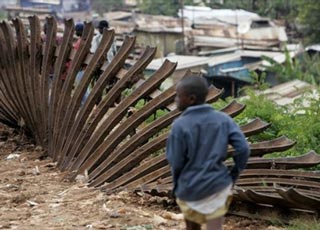
By Independent Team
On April 15, transport ministers of the East African Community countries were locked in a meeting in the Tanzania city, Arusha where the body is headquartered.
The topic of their meeting was: Railways Master Plan; the EAC Transport Strategy and Road Sector Development Programme.
In attendance was ministers Linda Bihire of Rwanda, Philipe Njoni of Burundi, John Nasasira of Uganda, Chirau Ali Makwere of Kenya (transport), Samuel Poghisio of Kenya (Commnunication), Wilfred Machage of Kenya (Roads), Ezekiel Chibulunji of Tanzania, and Maua Daftari of Tanzania.
The ministers agreed that an EAC Transport Strategy urgently needed in the context of the East African Trade and Transport Facilitation Project, which is a regional project aimed at facilitating transportation and flow of goods across the borders.
They noted that transport costs in the region constitute an average of 30% of the value of exports and imports and this has in turn made the region less competitive on the international scene.

On the afternoon of the same day that the ministers held their deliberations, barely 260 kilometres away in the slums Kenyan capital Nairobi, an event was happening that would pour cold water on their talks.
On that afternoon, gangs of protesters pounced on a section of the Nairobi-Kampala railway line that crosses the Kibera slums.
By the time the Kenyan police restored order, one person was dead and over 100 metres of rail had been uprooted.
Reports from the slum say the protesters were chanting: ‘Migingo, migingo, Migingo’.
But area residents say the protests were sparked when officers of the Kenya Power and Lighting Company swooped on the area to disconnect illegal power users.
Kibera is Africa’s largest slum and home to nearly one million people, who are poor and lack basic services like water, health services and power.
The culprits instead turned on the power engineers, chasing them with sticks and machetes before police, firing bullets and teargas, restored order.

Since then, analysts have noted that both the power incident in the Kibera slum and the squabbling between Kenya and Uganda over the one-acre rock in Lake Victoria are signs of greater underlying tension.
Just a week earlier on April 8 according to the Standard newspaper of Kenya, elders in the Nyanza are had vowed to disrupt rail and road transport to Uganda.
The Standard said they were angry that Uganda was imposing taxes on Kenyan fishermen in the Migingo Island area.
According to the Standard newspaper, uprooting the rail and disrupting road transport is designed to sabotage the Ugandan economy that heavily relies on the Mombasa port for 95% of its imports.’Ugandans need to know we feed them. They should not try to intimidate the hand that feeds them,’ the youth, reportedly, said.
Two days after the Kibera incident, when the EAC transport ministers concluded their meeting Arusha with a press statement, they did not mention the uprooting of the rail. They should have.
This is the second time protesters in Kenya are expressing frustration against their government by uprooting the rail.
In January last year, at the height of Kenya’s post-election violence, Kenyan vandals uprooted up to 500 metres of rail in the Kibera area. They were joined by others who uprooted up to two kilometers of rail in Kisumu and intercepted and burnt trucks and buses heading in the Uganda direction.

At the time, the protesters claimed they were ‘punishing Uganda for siding with Kibaki against Raila’.
Now, as in the past, by attempting to punish Uganda the protesters disrupt the economies of Rwanda, Burundi, the eastern Democratic Republic of Congo, and Southern Sudan.
These countries, and parts of northern Tanzania, depend on the Indian Ocean port of Mombasa for trade with rest of the world.
Most of these countries are urgently seeking alternative routes for their imports.
If that should happen, the Kibera vandals attempting to cut off the hand that feeds Uganda, might end breaking the pot in which there own food is cooked.
Kenyan manufacturers, who are the real engine the Kenya economy, depend heavily on the Ugandan market.
According to data from the Export Promotion Council of Kenya, Uganda was Kenya’s top export destination accounting for 12%, the UK was second at 10%, Tanzania third at 8% and Sudan 7th at 5%.(see tables)
In June 2008, while handing over the chairmanship of the EAC to Rwanda’s President Paul Kagame in Kigali, President Yoweri Museveni the heads of state Summit that intra-EAC trade has increased.
He said Uganda’s exports to Kenya and Tanzania had increase by 34% (2006) and 123% (2007) respectively. In 2005/2006 Uganda exported goods and services to Kenya and Tanzania worth Shs 157 billion and Shs 28 billions respectively. In 2006/2007, the figures had gone up to Shs 270 billion and Shs 46 billion respectively.
Meanwhile, Museveni said, Kenya’s exports to Uganda, over the same period were US$ 520.6 million (2005) and US$ 401 million (2006) respectively. Tanzania exports to Uganda were worth US$ 30 million (2005) and US$ 28 million (2006) respectively.
Uganda’s exports to Rwanda were US$ 30.5 (2006) and US$ 83.3 million (2007) and those to Burundi were US$ 20.5 million (2006) and US$ 42.7 million (2007).
As the figures indicate, Kenya remain the EAC’s economic power-house but unless its vandals are checked, its supremacy could be eroded further.
 The Independent Uganda: You get the Truth we Pay the Price
The Independent Uganda: You get the Truth we Pay the Price


